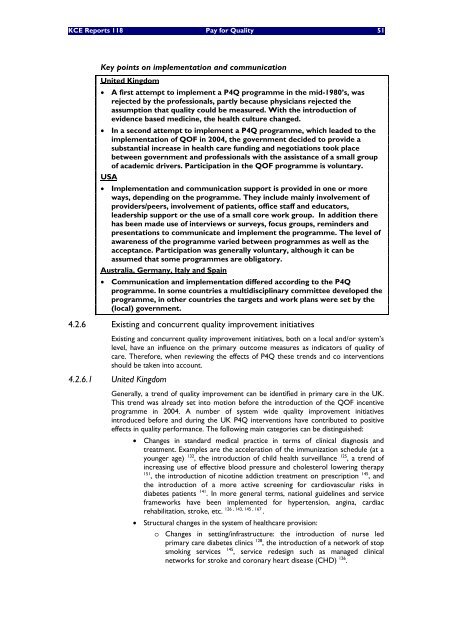Pay for Quality
Pay for Quality
Pay for Quality
You also want an ePaper? Increase the reach of your titles
YUMPU automatically turns print PDFs into web optimized ePapers that Google loves.
KCE Reports 118 <strong>Pay</strong> <strong>for</strong> <strong>Quality</strong> 51<br />
Key points on implementation and communication<br />
United Kingdom<br />
• A first attempt to implement a P4Q programme in the mid-1980’s, was<br />
rejected by the professionals, partly because physicians rejected the<br />
assumption that quality could be measured. With the introduction of<br />
evidence based medicine, the health culture changed.<br />
• In a second attempt to implement a P4Q programme, which leaded to the<br />
implementation of QOF in 2004, the government decided to provide a<br />
substantial increase in health care funding and negotiations took place<br />
between government and professionals with the assistance of a small group<br />
of academic drivers. Participation in the QOF programme is voluntary.<br />
USA<br />
• Implementation and communication support is provided in one or more<br />
ways, depending on the programme. They include mainly involvement of<br />
providers/peers, involvement of patients, office staff and educators,<br />
leadership support or the use of a small core work group. In addition there<br />
has been made use of interviews or surveys, focus groups, reminders and<br />
presentations to communicate and implement the programme. The level of<br />
awareness of the programme varied between programmes as well as the<br />
acceptance. Participation was generally voluntary, although it can be<br />
assumed that some programmes are obligatory.<br />
Australia, Germany, Italy and Spain<br />
• Communication and implementation differed according to the P4Q<br />
programme. In some countries a multidisciplinary committee developed the<br />
programme, in other countries the targets and work plans were set by the<br />
(local) government.<br />
4.2.6 Existing and concurrent quality improvement initiatives<br />
Existing and concurrent quality improvement initiatives, both on a local and/or system’s<br />
level, have an influence on the primary outcome measures as indicators of quality of<br />
care. There<strong>for</strong>e, when reviewing the effects of P4Q these trends and co interventions<br />
should be taken into account.<br />
4.2.6.1 United Kingdom<br />
Generally, a trend of quality improvement can be identified in primary care in the UK.<br />
This trend was already set into motion be<strong>for</strong>e the introduction of the QOF incentive<br />
programme in 2004. A number of system wide quality improvement initiatives<br />
introduced be<strong>for</strong>e and during the UK P4Q interventions have contributed to positive<br />
effects in quality per<strong>for</strong>mance. The following main categories can be distinguished:<br />
• Changes in standard medical practice in terms of clinical diagnosis and<br />
treatment. Examples are the acceleration of the immunization schedule (at a<br />
younger age) 132 , the introduction of child health surveillance 125 , a trend of<br />
increasing use of effective blood pressure and cholesterol lowering therapy<br />
151 145<br />
, the introduction of nicotine addiction treatment on prescription , and<br />
the introduction of a more active screening <strong>for</strong> cardiovascular risks in<br />
diabetes patients 141 . In more general terms, national guidelines and service<br />
frameworks have been implemented <strong>for</strong> hypertension, angina, cardiac<br />
rehabilitation, stroke, etc. 126 , 143, 145 , 167 .<br />
• Structural changes in the system of healthcare provision:<br />
o Changes in setting/infrastructure: the introduction of nurse led<br />
primary care diabetes clinics 128 , the introduction of a network of stop<br />
smoking services 145 , service redesign such as managed clinical<br />
networks <strong>for</strong> stroke and coronary heart disease (CHD) 126 .
















